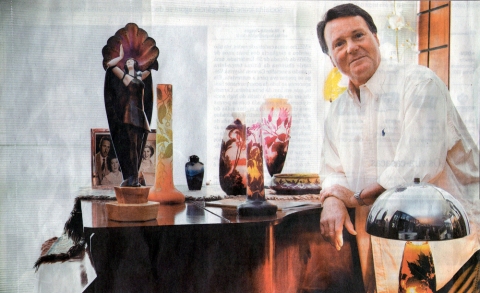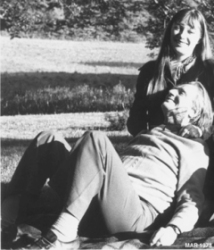
Marcio Roiter, Guardian of Times Gone by
by Mrs. Beth Orsini for O Globo Brazil
The dealer and researcher describes his eternal struggle to preserve the Art Déco style
The baritone voice suggests that we are talking to an opera singer, but no. Marcio Roiter, antique and arts dealer, is not the singing type. He is without a doubt the most celebrated master on Brazilian Art Déco heritage. In his two-story apartment at the heart of the Jardim Botânico neighborhood—where he lives surrounded by pieces by Gallé, Lalique, Sabino, Schneider and other treasures of their era—he breathes a sigh of relief. ‘Finally, Rio de Janeiro has discovered its Art Déco calling. Several abandoned buildings may regain the glamour of the 1920s, 30s and 40s,’ says enthusiastically the ‘father’ of Nega Fulô and Maria do Céu, two Labradors who move freely around the house without breaking a single piece.
Roiter pauses for a protest. He tells us that, in 1993, during the 2nd World Congress in Perth, Australia, it was agreed that Art Déco would always be written in capital letters. ‘But many members of the media have refused to comply, I don’t quite understand the reason,’ complains the art dealer, taking the opportunity to praise one of the greatest collectors of Art Déco in the world Joe Berardo’s plan to install his collection in Rio de Janeiro. ‘For about two years, I have been working towards this goal. It would be perfect if the building behind the former Casino da Urca, overlooking the beach, was finally occupied by the Berardo Museum, which is another battle of mine.’
A tireless fighter, he started a quarrel with the community association for the Urca neighborhood, which accuses him of arrogance. ‘When I tried to bring the Berardo Museum to that location, they were willing to accept, but only if there were no openings. Soon they will ban people from other neighborhoods from using the beach there. Because of this intransigence, this gem from the 1930s remains neglected. It is a pity, since an Art Déco museum of this size, in Rio, would consecrate the city as the capital of the style.’
A tough guy, he acknowledges that this eternal battle to preserve the style earned him many enemies. ‘I dive into the sea to renew my energy because the load is heavy. During a recent retrofit at the Gloria neighborhood, for example, there were attacks from neighbors. Residents think they’re going to lose the view because of a construction being added to the Paranaguá building to make the venture viable. People are afraid of what is done, while complaining their neighborhood is neglected. After Downtown, Gloria is the district with the most preserved monuments.
Without displaying any false modesty, he says he is aware of the fact that his work has a significant impact on the preservation of the city’s Déco. ‘I’ve planted a seed that has blossomed last year during the 11th World Congress on Art Déco, the first to happen in Latin America.’, tells us the researcher who chairs the Institute Art Déco Brazil, opened in 2005, which is located in the Jardim Botânico neighborhood and along the second half of the year will offer several courses on the subject.
But when did this passion start? At the A Noite Building, where Roiter accompanied his mother, Maria de Lourdes Alves, who lead the show Clube Juvenil Toddy (or Toddy Youth Club), on Radio Nacional between 1950 and 1960. ‘It was the first skyscraper in South America. The entrance was all done in marble and ornate with many chromed pieces,’ tells us the dealer who now and then would rub shoulders with artists such as Marlene and Emilinha.
When his mother chose to stay home with the children, the boy fell in love with the Essenfelder piano, which he had to clean in order to earn pocket money from his parents. ‘I’ve polished that piano, which is now in my house, so often that I became an expert in Art Déco. I had to polish the golden brass pedals until they were shining brightly. It was a wedding gift from my father to my mother. He thought the piano was beautiful, all done in imbuya.’
It was the desire to devote all his time to Art Déco that made Roiter, 60, give up his medical calling and quit the School of Industrial Design. ‘Back then, people did not value the pieces they had. They usually hated receiving Déco pieces as wedding gifts, such as ivory dancers, now worth 100 thousand dollars. They gave the pieces for children to color. It was then that Roiter realized the importance of those objects and began to buy a few: ‘It was all very inexpensive!!’
And so Paris became an inevitable destiny. In 1968, he spent a month in the city, experiencing all its effervescence. He ended up meeting Yvonne Brumhammer, head of the Museum of Decorative Arts at the Louvre. ‘I’ve worked with her in the Paris Museum, and Yvonne eventually became my guru,’ jokes Roiter, author of “Rio de Janeiro Art Déco,” a book about the movement in Rio de Janeiro, a city that has the largest collection of Art Déco buildings and structures in Brazil – about 300.
An avid collector, Roiter has 4,000 books and, at one time, had as many as 10,000 pieces at home. Upon returning from Paris, he realized is collection was modest and began to invest in it. That’s when it began making me money. I bought my first apartment at the exclusive Delfim Moreira Avenue with the money from the sale of a pair of lamps by Armand Rateau, which I bought in Rio and sold in New York. Rateau was one of the finest designers and architects of the period, and worked for very few families. Today, these fixtures are worth about two million Euros.
Son of a doctor (Moisés Roiter), he says after he opened the Art Déco Brazil Institute seven years ago, he started to ask people to join as members and pay an annual fee. ‘I keep the institute at my expense. Its headquarters are in a house I own at Pacheco Leão Street, and I lose about seven thousand dollars a month because of it. Therefore, I ask the building managers who call me for advice to enroll the building among the members of the institute.’ And it is with this indescribable enthusiasm that Roiter talks about the passion that gives meaning to his life.
According to him, a life turned around after he suffered two accidents. In 1973, he crashed his green VW Beetle and spent months at home reading compulsively – about Art Déco, of course. In 2001, he fell from a height of six meters and broke his femur at the Primatas Trail, in the Jardim Botânico neighborhood. ‘I thought I would die and I felt I should do something more than buying and selling art pieces. It was then that I started writing my book and scheduling appointments with students and people interested in the subject,’ says the dealer, who has had a stand at the Praça XV antique fair and a store inside Rio Design Leblon. People used to say Roiter drove people away. ‘It’s a lie, I drove away people who were just curious and could put the pieces at risk, thus selecting the clientele,’ he explains.
Keeping in mind foreigners are increasingly curious about our Déco heritage, he quips. ‘When the gringos are interested in something we, Brazilians, get all excited. Starting in August, we’ve attracted one hundred new members to the Art Déco Brazil Institute – people concerned about this heritage. But our goal is to reach two thousand people, like New York.’
Márcio Alves Roiter
Founder-President Instituto Art Déco Brasil
55 21 25115537
55 21 99851084
marcioroiter@uol.com.br
www.artdecobrasil.com




.jpeg)




.png)
Comments
I am in love with Art Deco because it was the last truly original, soaring, and exciting design.
Many people have no idea the specifics and unique characteristics of Art Deco and would appreciate
it so much more if they did. I wish Marcio success in his efforts.
Add new comment